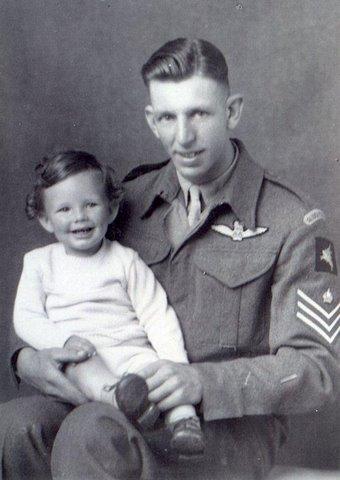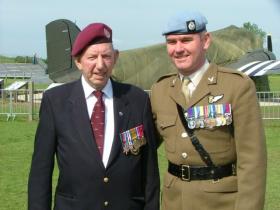Arthur Shackleton joined The Duke of Wellington’s Regiment in 1939, before transferring to work on Farms as a labourer to help with the harvest.
He was then ordered to join The Royal Horse Artillery where he became a Despatch Rider. Keen to see action, Arthur volunteered for the Glider Pilot Regiment in October 1942. There followed intensive training but Arthur did not see action during the Normandy Landings and was frustrated by the successive planning and cancellation of Airborne Operations across France and Holland. Finally, whilst serving with HQ B Squadron, Glider Pilot Regiment Arthur flew as Maj Toler's co-pilot to Arnhem, during Op Market Garden.
They were assigned to fly Lt Col. WDH McCardie, the Commanding Officer of the South Staffs, together with five of his men and a jeep and trailer. During the morning of Sunday, 17th September 1944, their glider was the first of ‘B’ Squadron to take off. After an uneventful flight apart from turbulence caused by slipstream and an over-crowded airspace the landed without undue incident. The South Staffs were ordered to reinforce 2 Para at the Arnhem Bridge but although they fought their way well into the town they failed to reach the bridge. By 25 September Arthur (then acting as Maj Tolers bodyguard) visited many outposts with the Major to give instructions and orders to withdraw.
During the final stages of the withdrawal and close to the riverbank the pair came upon a file of airborne troops who were without a leader and knew not what to do. Asserting the authority of his rank the Major put them in charge of his Staff Sergeant with a promise that the NCO would lead them to the river bank. Sadly, within minutes the party were ambushed and caught by an accurate burst of machine gun fire and few survived.
Arthur received a bullet wound to his shoulder but he staggered to the river bank where he met up again with Ian Toler and at the Major’s insistence was put aboard a boat for evacuation with the other wounded. In mid-river the German mortar bomb found its target. After he was dragged from the river more dead than alive he was taken to a Field Dressing Station where the Medics first attempted to remove the bullet and pieces of shrapnel from his shoulder, leg and the rest of his body. From then on he was sent to a succession of hospitals, firstly Nijmegen then Brussels, and by Dakota to an airfield in England then, eventually, by hospital train to St Elizabeth’s Hospital Birmingham.
After being pronounced fit, Arthur rejoined his unit and there followed further training until his next operation - Varsity, The Rhine Crossing on 24 March 1944. The flight across the North Sea to the target was relatively uneventful but the reception given by the enemy over the Rhine was hostile, noisy and nasty. This hazardous situation was made worse by smoke laid down to cover the river crossing of our land forces. The smoke created a condition of almost nil visibility for the descending airborne soldiers. After release, and on the final approach, enemy anti-craft gunners blew away a large chunk of Arthur’s starboard main plane and shredded his rudder. Despite smoke, shot and shell, fortune favoured the brave and he managed to land his Horsa without serious hurt to members of the six-pounder anti-tank gun team aboard the glider. However, the quick release mechanism used to secure the gun and jeep towing vehicle had become fused after being struck by anti-aircraft fire and rendered inoperable. A nearby REME unit came to the rescue, remedied the damage, and off went gun and crew to engage the enemy and perform their allotted task.
Following spells at Keevil, Blakehill Farm and a summer interlude at Watermouth Castle near Ilfracombe, the Squadron Rest Camp, Arthur was demobbed. The year 1946, the place Finmere “Age and Service Group 26”. Whilst at Finmere he had the distinction of being selected as a member of an Honour Guard for the lying-in-state of Admiral Lord Keyes. Lord Keyes was the leader of the rail on the U-boat base at Zeebrugge in 1918 and was the first Director of Combined Operations to be appointed in The Second World War.
After demob Arthur settled down to family life in Bournemouth and with his wife Nell raised three children. Sadly soon after his celebrating their Golden Wedding Anniversary Nell died and Arthur was left a widower.
He lived with his second wife Margaret, in Hardy countryside not far from Dorchester. Happily for the GPR Association Margaret joined Arthur in his very strong and committed support of the Wessex Branch and the Association.
Arthur passed away aged 96 on 28 December 2014.
Edited by Mike Peters in consultation with Arthur Shackleton. Transcribed by Jo Hook.
Read More





Latest Comments
There are currently no comments for this content.
Add Comment
In order to add comments you must be registered with ParaData.
If you are currently a ParaData member please login.
If you are not currently a ParaData member but wish to get involved please register.